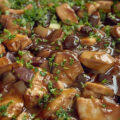“Who Used Recipes? We just Cooked!”
From the first ancient Biblical Exodus to the modern 20th century Exodus, Jews brought their foods out from Egypt.
Food, in many ways, is culture. Certainly, the long history of Jews in Egypt reveals much intermingling of Jewish and Arab societies. But it’s not quite that simple. While keeping kosher was a distinct aspect of food preparation, unsurprisingly, Jews in Egypt ate much like their neighbors.
Jews and non-Jews alike came to Egypt from Europe and the Middle East. Egypt, like Israel, was on the crossroads of ancient trade routes. You see this in the Biblical story of Joseph, when his brothers sold him to traders on their way to Egypt. Traders brought spices, foods and methods of preparation. As many merchants were Jews in the ancient world through the 19th century, in a sense, Jews were part of a global culinary community.
Molded by history, religion, and spice trade routes, Egyptian Jewish cooking included stews, soups, stuffed vegetables, and cool salads for hot weather, using spices now thought of as Middle Eastern: allspice, cardamon, cinnamon, cumin, among others. A few popular Egyptian dishes, eaten by Jews, Christians and Muslims alike, are:
- Koshari, a “national” Egyptian dish, whose name may come from the word “kosher,” consists of pasta, rice, lentils, chickpeas, caramelized onions, and a vinegary tomato sauce. Koshari is a low cost and nutritious meal.
- Warak Enab, grape leaves stuffed with herb and spice-flavored rice, often ground meat, is simmered in tomato sauce. Served with lemons.
- Falafel, from dried fava beans, is made into balls, fried, and eaten in pita with vegetable and hummus. In Israeli and most Jewish recipes, falafel is made with chickpeas.
- Ful Mudammas, is a popular fava beans and lentils dish.
- Mujaddara is made of rice, lentils and sautéed onions.
- Stuffed vegetables. “If it was a vegetable, we stuffed it!” an Egyptian Jewish friend told me.
Today, Egypt has few Jews, yet at other times the country was a sanctuary. Jews fled to Egypt throughout the Spanish Inquisition, begun in 1492, and through the eras of European pogroms, organized massacres, from the Middle Ages to the 19th century. This history created distinct Jewish communities. Egyptian Jews had a dhimmi or second-class status, with periods of persecution and difficulties, yet life was relatively secure and many were prosperous. All these Jewish immigrants to Egypt brought their own food traditions with them, adapting them with ingredients they found in Egypt.
 Cairo Geniza, Old Jewish Manuscripts
Cairo Geniza, Old Jewish Manuscripts
The history of Jews in Egypt is ancient and reveals a close connection to food. The fearful fleeing slaves of the Biblical Exodus complained they wanted to return to Egyptian slavery, to eat cucumbers, melons, leeks, onions and garlic. When hurriedly leaving Egypt, the Bible tells us the Jews baked the bread dough before it could rise, the origin of matzah. Then again after Nasser’s ascent to power and especially from 1948-1956, in a second Exodus from Egypt, Jews brought their foods out, fleeing to Israel, Europe, and North and South America.
I asked my friend, Adela Dwek Baum1, an Egyptian Jew, if she felt a connection to these Jews of the Biblical Exodus, commemorated at Passover. “One hundred percent! Even until now,” she said. For her, history was personal.
Adela’s family, like many Jews all over the Middle East and Europe, migrated during the “Golden Age,” the time of building the Suez Canal and the prosperity it brought. Her family came from Syria where jobs were scarce and the economy poor. Colonialized Egypt was then prosperous and cosmopolitan. Many Jews in both Cairo and Alexandria were well off, well-educated, and multilingual. They existed within tight-knit and supportive communities. The Cairo Jewish schools and hospital, Adela told me, were supported by wealthy Jewish families. Ashkenazi and Sephardic communities, for the most part, remained separate. Food reflected the various origins of the immigrants, as well as blending into Egyptian cuisine.
 Egyptian Jewish Girls
Egyptian Jewish Girls
Adela was raised speaking Arabic and French, going to Jewish elementary schools and a French Lycée (high school). But she felt Egyptian, not French, and her daily and holidays food were Arabic and Middle Eastern.
“Every Thursday, we had Mujaddara, a dish made of lentils and onions, with a salad of tomatoes and cucumbers, and yogurt. We all did. Didn’t everybody, even the Ashenazim? We wanted dairy because we would have meat on Shabbat.” Following kosher traditions, meat and dairy would not be eaten together. On Friday, pots filled with Hamin, a Sephardi Cholent, were brought to the bakers to be baked overnight and eaten at lunch.
Salads and vegetables were very much a part of the Egyptian and Jewish diet. “We were organic,” Adela told me. “Not by choice. That’s how it was. The local farms to our tables. Milk was delivered from cows that were raised nearby. My mother boiled the milk and took the cream off the top. We had a very good life. I went out with friends—we felt safe.” That life was coming to an end. During the 1930’s through the 1940’s, hatred of Jews increased and there was often violence.
Adela told me “After 1948, that was it; 1948 was the end of all.”

By the summer of 1943, the Allies had defeated the Nazis and their allies in North Africa. Many soldiers traveled to Cairo to visit, what was to them, an exotic and mysterious culture, my father among them. He told me of the veiled women, men in long robes and the winding alleys of the souk, the outdoor market and bazaar, established in the 14th century. He managed to find Jewish merchants, converse with them in Hebrew and establish that he, much to their surprise, was also Jewish. Continents and cultures apart, they felt a connection.
With Nasser firmly in power and after Israel had won several wars, the last Jews fled or, like Adela, were expelled. She was 16. Today, there are only few elderly Jews in Egypt, its long history over.
The Egyptian Jews brought their food out of Egypt, continued making it in their kitchens and restaurants. Middle Eastern and Mediterranean foods are extremely popular today. People love the fresh vegetables, savory sauces and dips, versatile spice mixes, and the healthy lifestyle this food promotes.

While not nostalgic for Egypt, Adela remains tied to her personal and collective memories through food. However, when I asked her for a recipe for Mashi, Stuffed Vegetables, she just laughed. “Who used recipes? We just cooked!”
Don’t worry, I turned it into a recipe you can follow. Get the recipe here.
- Adela Dwek Baum is a pseudonym, protecting the privacy of my friend who graciously shared her memories.
















